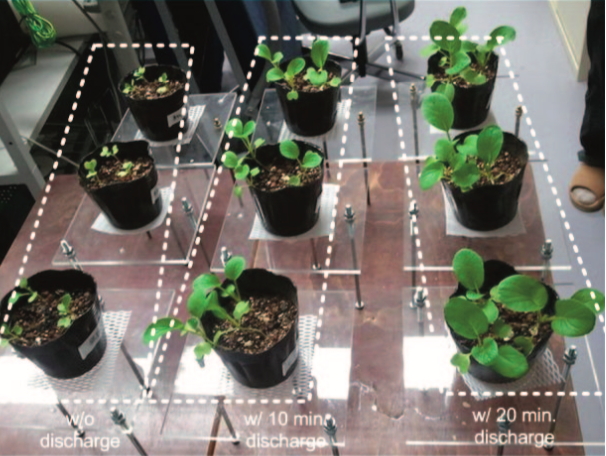Professor Koichi Takaki discusses how combining electricity and biology could create a sustainable food supply
Growing populations, a changing climate, decreasing amounts of farmland and lower fertility soils are just a few of the many problems facing the world’s food supply. Because of these multitude of changes, the agricultural industry and researchers recognise a dire need for more sustainable agriculture practices and technologies. Novel technologies and methods of improving crop yields while reducing waste throughout the food supply chain are two ways that we can reduce the pressure on our already stretched food supplies. A more sustainable and less wasteful system can also go a long way to providing higher quality goods to the segments of society that do not have the luxury of shopping at continually stocked, modern grocery stores. The methods used to tackle this problem vary, from increasing soil fertility via improved management practices to genetically modifying agriculture products themselves. Each comes with its own drawbacks and public perceptions of the impacts. But what they all have in common is the need for a multi-disciplinary approach involving botanists, biologists and chemists. There will never be one magic bullet solution and collaboration not only leads to novel applications it also breeds innovation and produces advances in knowledge that may one day inspire new breakthroughs. Our group is taking this approach to heart and blending the fields of high-voltage electrical and plasma engineering with biology in the hopes of providing a jolt to the entire agricultural industry.
How would combining electricity and biology work?
The combination of electricity and biology may sound like the stuff of science fiction, but electrical currents flow through all living tissues from cells to organs, so it should come as no surprise that electrical stimulation can in fact influence various biological processes. Teams of engineers and biologists have already designed several techniques for agricultural applications. Pulse-electric fields and electrostatic effects have long been used in agriculture and food processing as electro-spray or electroporation. These two techniques improve the attraction of liquid molecules to crops and increase the permeability of cell membranes for a variety of microbiology applications. Recently, pulse voltage and plasma are the newly employed techniques in agriculture and food processing and we are focusing on seed germination promotion, seedling growth enhancement and the inactivation of bacteria.
Our group aims to develop methods of novel functional control of plant and marine products based on pulsed power technologies. In doing so we will also contribute to an overall deepening of the scientific understanding of agriculture and food science. Many types of repetitively operated, compact high-voltage power supplies with moderate peak power have been developed for agricultural and food processing applications. These applications are mainly based on the biological effects of specially distributed electric fields and the chemically active species produced by the plasma. The work of our group therefore involves the design and optimisation of new power supplies and then the application of high-voltage plasmas to both the pre- and post-harvest life stages of plants. For a power supply the group uses what is called a pulse power generator. We have studied in detail the fundamental characteristics and applications of high voltage pulsed power systems and plasma discharge for industrial uses, environmental applications and as scientific tool development. The benefit of such a system is the fine levels of temporal and spatial control of the generated energy. This allows the team to make detailed observations on the effects of high-voltage plasmas on small biological molecules like proteins and amino acids and the tissues in which they reside.
How has the use of high-voltage plasma worked?
Our group has already seen success in using high-voltage plasma to increase the growth and fruition of some plant and fungi species. We have reported that Japanese mustard spinach leaf growth rose over 28 days with increasing amounts of plasma treatment time. We also found that by applying 50 kV stimulation, two species of mushrooms grew faster and had increased average yields of the fruiting bodies. These two results demonstrate their work’s success in the pre-harvest phase. We were proud to report success in the post-harvest phase as well. The post-harvest phase simply refers to a products journey to the consumer once it has been picked from the field. During this trip it is essential that products remain fresh so as to reduce waste and ensure a high-quality product on arrival. In their experiments with strawberries the team was able to supress the growth of mould on strawberries being preserved post-harvest by applying an AC electric field. Ethylene, C2H4, is a gas and component of plant hormones and it promotes the ageing of some kinds of fruits and vegetables. Decomposition of C2H4 using a dielectric barrier discharge is therefore effective for keeping the freshness of fruits and vegetables. These successes were the first step in the long-term plan and clarified the dominant effects, including mechanisms, of high-voltage and plasma on plant growth, fruiting and maintaining freshness. The next step in the research plan is to clarify the element forming the basis of the relationship between high-voltage phenomena and plant metabolism.
How can this lead to a sustainable food supply?
Our final goal is to contribute to a sustainable food supply chain using high voltage and plasma technologies and to do so a wide field of knowledge and technical skills related to engineering, biology and botany are essential. Therefore, partnerships and collaboration are essential to the success of the project. For example, if we try to design a mix loading container for exporting agricultural products that maintains freshness using AC high-voltage and plasma, we need many technologies and different expertise in the domains of plant metabolism, power supply, temperature control systems, economic evaluation and chemical materials. Each our group member brings a unique contribution to the novel research from knowledge on agricultural product preservation, skills for plasma application in food processing, analysis in plant metabolism along with hydroponic cultivation methods and environment controls in green houses. Without this interdisciplinary approach these novel technologies could never be realised. The problems facing the global food supply are many and therefore require a variety of solutions. Our research is one example of seemingly unconnected fields coming together to innovate new solutions and in doing so are also providing a field of knowledge for new generations of researchers to harvest.
Funding
Japan Society for the Promotion of Science; Grant-in-Aid for
Scientific Research (S); Broad Section C, ‘Novel function control of plant and marine products by pulsed power and its scientifically deepening’, Research Project Number 19H05611
Please note: This is a commercial profile











